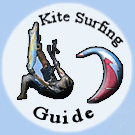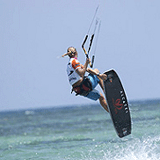Kite Tuning
Depending on the speed you want your kite to have, you can tune it to go faster or slower. Every kite has its own distinct tuning techniques and effects, because evry kite has its own aerodynamic characteristics. When buying a kite, you should be provided with the tuning methods of your kite. In case you don't get all this information at the stores, use these tips to find out how and when you can tune a kite:
Should you want your kite to turn slower:
- This is for when you are learning to kitesurf
- Also for nervous kites or in strong wind conditions
Should you want the kite to fly slower:
- Tune it if the wind is strong in your area
- Also in case you are still learning the hang of it
A kite can be tuned to turn faster:
- If the wind is light
- In case you are using a short control bar
The kite may be tuned to fly faster:
- Should the wind be light
- If the lines you are using are long , about 40 m
If the kite must be able to resist luffing and nose diving:
- Should there be gusty wind
A good idea in case you want the kite to turn faster would be to use a longer bar, or, on the other hand, if you want it to turn slower , a shorter bar is the key to it.
4 Line inflatable
4 line inflatable kites nowadays usually have 2 connection points for the the front lines and back lines.
- If you need more depowering capability, use the "front most" front attachment.
- Should you want more power on the harness line, you should use "back most" front attachment.
- To fast turning of your kite, you have to use the "back most" back attachment.
- To slow turning of your kite, a good thing would be to use the "front most" back attachment.
To sum up, for and wider wind range, the connection points must be used further apart. In case you wish more stability and lesser bar sensitivity, the connection points must be used closer together .
Foils
Usually, 3 line foils are having the brake lines attached to the center of the bar and the front lines both attached to the ends of the bar. In most cases, this leads to needing a power steering line to attach each front line to its corresponding trailing edge. So, the power steering line should have no tension or slack while the kite flies straight overhead. The kite will be turned "unluffable" no matter that there can be quite gusty wind conditions. All this just by properly tuning the power steering line. Remember that the power steering lines are very similar to an "automatic" brake, that should stop the kite in case it might overfly.
The Concept Air kites offer the possibility to be tuned by using a VSS system , so that they would fly faster or slower. Just like this type of kites, a foil can be also tuned to fly faster or slower. The interesting thing to know is that the Concept Air kite bridal is made up of three sections: the front bridal, the middle bridal and the trailing edge bridal. The trailing edge bridals are connected to the brake lines , while the front and the middle bridals are connected to the front lines. The kitesurfer using such a kite type will be able to adjust the angle of attack of the kite, by using the VSS system that has a number of attachment knots. The kiter may simply shorten the front bridal, decreasing the angle of attack and thus making teh kite fly faster, or, on the other hand, a kiter may lengthen the front bridal and shorten the middle bridal at the same time, in order to increase the angle of attack. This way, his kite will fly slower, as it will have more pull.


